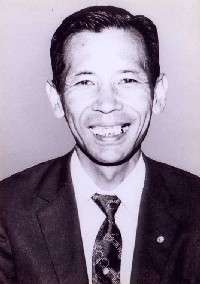Saburo Hasegawa
Saburo Hasegawa (長谷川 三郎, Hasegawa Saburō, 1906-1957) was a Japanese calligrapher, painter and early advocate of abstraction.
Saburo Hasegawa | |
|---|---|
 | |
| Born | 1906 |
| Died | 1957 |
| Nationality | Japanese |
| Alma mater | Tokyo University of the Arts |
| Known for | painting |
| Style | abstraction, calligraphy |
Life and education
Saburo Hasegawa was born in Chōfu, Tokyo. In 1926, he graduated from the Tokyo University of the Arts with a thesis on Sesshū Tōyō.[1] During this time he also studied under Narashige Koide in Osaka. From 1929 to 1932, he traveled to the United States and to Paris, where he exhibited at the Salon d'Automne. While back in the United States around 1950, he and Isamu Noguchi met and became good friends. Noguchi said he considered Hasegawa a teacher and during their time together they traveled to Japan in search of a way to connect its past and future artistic aesthetics. In 1954 Hasegawa became an ambassador of the Japanese avant-garde.[2] He was a visiting professor at the California College of Arts and Crafts, where he lectured on the history of art in the Far East and on Zen. He died in San Francisco in 1957.[3]
Work
In his paintings, Hasegawa merged the gesturalism of Japanese calligraphy, of which he was a master, with the spontaneity of Western abstraction.[4] Isamu Noguchi introduced Hasegawa to the paintings of Franz Kline, which Hasegawa published in the monthly journal Bokubi (墨美, Beauty of Ink) published by Morita Shiryu of the Bokujinkai calligraphy group.[5] Hasegawa wrote extensively on European modernism, and he introduced Japanese artists to surrealism and abstract expressionism.[6]
Collections
Hasegawa's work is held in permanent collections including:
- San Francisco Museum of Modern Art, San Francisco, CA.[7]
He was also included in the 'Changing and Unchanging things: Noguchi and Hasegawa in Postwar Japan' exhibition located in the Noguchi Museum. The exhibition holds around 90 works from the artists, and features Hasegawa's paintings, calligraphic drawings and some of his poems.[8]
| Wikimedia Commons has media related to Saburo Hasegawa. |
Footnotes
- Turner, Jane (editor), The Dictionary of Art, Macmillan Publishers Ltd., London, 1996, ISBN 1884446000, Vol 14, p. 213
- The Saburo Hasegawa Reader. United States, University of California Press, 2019.
- Dictionnaire critique & documentaire des peintres sculpteurs dessinateurs & graveurs. Gründ, Hilmarton Manor Press. 1999, p. 788
- Papanikolas, Theresa and Stephen Salel, Stephen, Abstract Expressionism, Looking East from the Far West, Honolulu Museum of Art, 2017, ISBN 9780937426920, p. 17
- Papanikolas, Theresa and Stephen Salel, Stephen, Abstract Expressionism, Looking East from the Far West, Honolulu Museum of Art, 2017, ISBN 9780937426920, p. 14
- Papanikolas, Theresa and Stephen Salel, Stephen, Abstract Expressionism, Looking East from the Far West, Honolulu Museum of Art, 2017, ISBN 9780937426920, p. 17
- "Works in the Collection: Saburo Hasegawa". SFMOMA. Retrieved 7 December 2018.
- Esplund, Lance. "'Changing and Unchanging Things: Noguchi and Hasegawa in Postwar Japan' Review: Beauty Without Borders". WSJ. Retrieved 2019-12-02.